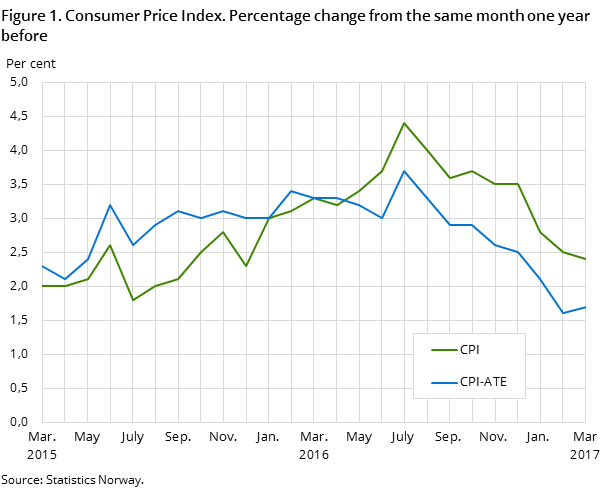Content
Published:
This is an archived release.
Increased clothing prices in March
The Consumer Price Index (CPI) rose 0.3 per cent from February to March. The year-to-year growth in the CPI was 2.4 per cent in March, down 0.1 percentage points from February.
| Index | Monthly change (per cent) | 12-month rate (per cent) | |
|---|---|---|---|
| March 2017 | February 2017 - March 2017 | March 2016 - March 2017 | |
| CPI All-item index | 105.0 | 0.3 | 2.4 |
| Food and non-alcoholic beverages | 102.0 | -0.4 | 3.0 |
| Alcoholic beverages and tobacco | 105.5 | -0.2 | 2.3 |
| Clothing and footwear | 105.9 | 7.1 | 2.1 |
| Housing, water, electricity, gas and other fuels | 107.3 | 0.0 | 4.0 |
| Furnishings, household equipment and routine maintenance | 105.6 | 0.4 | 0.1 |
| Health | 104.3 | 0.5 | 3.4 |
| Transport | 103.8 | 0.3 | 0.5 |
| Communications | 105.2 | -0.2 | 1.9 |
| Recreation and culture | 105.4 | -0.8 | 2.4 |
| Education | 107.0 | 0.0 | 5.3 |
| Restaurants and hotels | 106.2 | -0.1 | 3.6 |
| Miscellaneous goods and services | 103.7 | 0.6 | 2.2 |
| CPI-ATE All-item index | 104.0 | 0.4 | 1.7 |
| CPI by delivery sector | |||
| Consumer goods | 105.6 | 0.4 | 3.0 |
| Services | 104.5 | 0.2 | 2.0 |
| Services where labor dominates | 105.2 | 0.3 | 3.2 |

The CPI-ATE rose 1.7 per cent from March 2016 to March 2017. CPI was 105.0 (2015 = 100) in March 2017, compared to 102.5 in March 2016, which corresponds to a year-to-year growth of 2.4 per cent.
Monthly change: prices increase on clothing
From February to March the CPI rose 0.3 per cent, mostly due to price increases on clothing. Many clothing stores switch stock from down priced winter clothes to newly arrived spring and summer clothing between February and March. All clothing sub groups had price increases in March; combined price increase was 7.7 per cent.
Energy prices combined fell 1.8 per cent last month, due to lower prices on petrol, diesel and electricity. The yearly book sales gave a price decrease of 17.5 per cent on books. Lower food prices also contributed to dampening the CPI rise.
Year-to-year growth: higher electricity prices
From March 2016 to March 2017, the CPI increased by 2.4 per cent, mainly due to higher electricity prices. Prices on electricity including grid rent rose 15.5 per cent the last twelve months, but the price level has remained more or less constant for the last four months.
Food prices were in March 2.8 per cent higher than they were in March last year, and together with increased prices on restaurant services and fuels contributed in the increased CPI.
A price fall of 24.4 per cent on airfares was the most important contributor in dampening the increase of the CPI. Lower airfares in March have to be viewed in conjunction with increased demand and prices during the Easter holiday that fell in March last year.
Change in the year-to-year growth: marginally lower growth rate in the CPI
The year-to-year growth in the CPI went down from 2.5 per cent in February to 2.4 per cent in March. The decreased growth rate was caused by the development in the prices of several consumption groups. Prices on fuels and books fell from February to March this year, while they rose in the same period last year. For airfares and furniture the monthly price increase in March this year was lower than in March last year. For some goods and services this diverging price development is due to the Easter effect.
The price development on food and clothing contributed to restrain the fall in the year-to-year growth rate
CPI-ATE rose 1.7 per cent in March, up 0.1 percentage points from February.
New detailed consumer classification, ECOICOPOpen and readClose
The CPI adopted Eurostat’s new detailed 5-digit consumer classification, ECOICOP in January 2016. Statistics Norway has published unofficial 5 and 6-digit COICOP indices for the consumer group Food and non-alcoholic beverages up until January 2016. As a result of a discrepancy between the unofficial and the new official ECOICOP, some previously published indices are no longer available. This results in new names for some of the published groups.
Representative goods and services in the CPI by delivery sectorOpen and readClose
Here is the detailed list of representative goods and services in the CPI by delivery sector. The list will not be automatically updated
Contact
-
Statistics Norway's Information Centre
E-mail: informasjon@ssb.no
tel.: (+47) 21 09 46 42
-
Konsumprisindeksen
E-mail: konsumprisindeksen@ssb.no
tel.: (+47) 62 88 56 34
-
Camilla Rochlenge
E-mail: camilla.rochlenge@ssb.no
tel.: (+47) 40 90 23 72
-
Kjersti Nyborg Hov
E-mail: kjersti.nyborg.hov@ssb.no
tel.: (+47) 40 90 23 63
-
Gunnar Larsson
E-mail: gunnar.larsson@ssb.no
tel.: (+47) 40 90 26 79
-
Trym Kristian Økland
E-mail: trym.okland@ssb.no
tel.: (+47) 46 81 09 15
